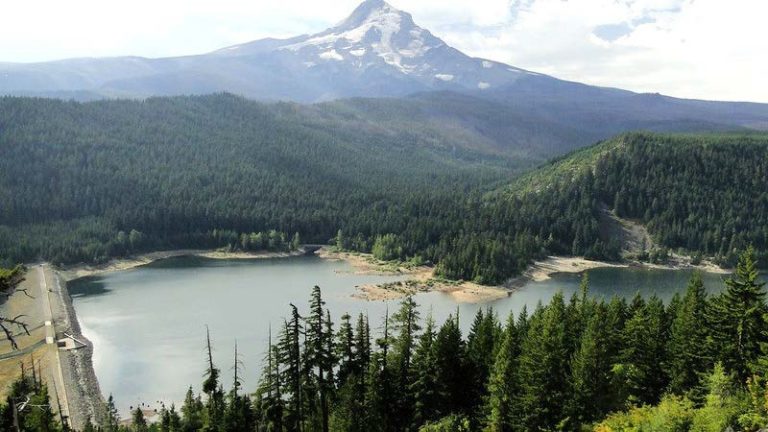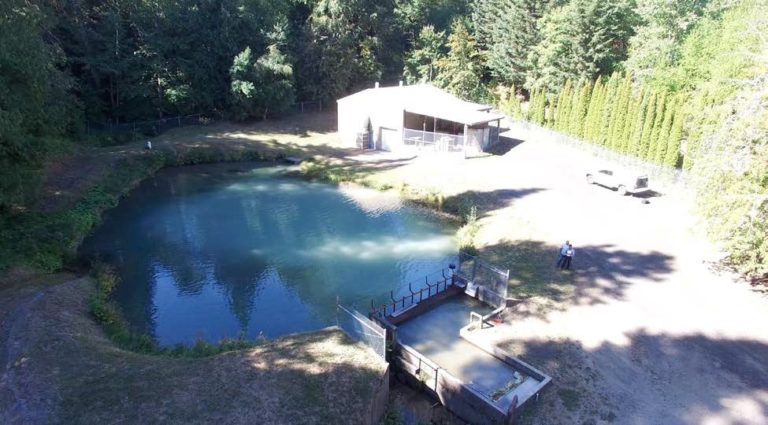LIHI Certificate No. #143 – Middle Fork Irrigation District Project, Hydro Plants No. 1 and No. 2, Oregon


| Project Name | Middle Fork Irrigation District (MFID) Hydro Plants No. 1 and No. 2 |
| LIHI Certificate No. | 143 |
| LIHI Certificate Term |
February 1, 2018 – January 31, 2033 |
| Owner | Middle Fork Irrigation District |
| State | Oregon |
| Location | River mile 9.4 on the Clear Branch of the Middle Fork, Hood River |
| Installed Capacity | Total: 2.5 MW
Hydro Plant 1: 2.0 MW Hydro Plant 2: 0.5 MW |
| Average Annual Generation | Total: 20,469 MWh
Hydro Plant 1: 16,575 MWh Hydro Plant 2: 3,894 MWh |
| Facility Type | In-conduit, run-of-river |
| FERC No. | P-4458, exempt 1984 |
The Middle Fork Irrigation District (MFID) Project is owned and operated by Middle Fork Irrigation District, a local irrigation utility that distributes water to nearly 6,400 acres serving approximately 400 users in the area.
The project is located near the town of Parkdale, Oregon, an unincorporated community in Hood River County, Oregon. The project was built in 1921 to meet the irrigation needs of the agricultural community in the upper Hood River Valley. Geographically, the project is located northeast of Mt. Hood, and project water flows from District points of diversion on the Clear Branch of the Middle Fork Hood River, northeast towards the Columbia River in Hood River, Oregon. Agriculture is the leading industry in the Hood River Valley.
The project included in the LIHI certification includes an intake structure at Clear Branch Dam at Laurence Lake, a Pelton turbine-generator unit located in the Unit 1 powerhouse and a small tailrace pond, a conduit connecting the pond to a Francis turbine-generator located in the Unit 2 powerhouse, and additional conduit that flows into the Unit 3 powerhouse, not included in the certification. Total installed capacity of Unit 1 and Unit 2 is 2.5 MW.
Unit 1 automatically responds to downstream flow demands by adjusting to maintain a constant water level in the preexisting tailrace pond. This water level is maintained below pond overflow elevation, so no water is spilled. Flows leave the Unit 1 tailrace pond and re-enter the conduit. Water is delivered to many submains or flow turnouts and fire protection facilities (fire hydrants), along the approximately 10,250 feet of conduit before entering the Unit 2 turbine. This unit operates such that the facility controls downstream pressure by modulating the wicket gates to maintain pressure in the conduit exiting the facility.
Prior to construction of the hydro facilities, the MFID utilized a large pressure reducing station at this location, dropping the system pressure across pressure reduction valves. These valves are still in existence but are used only as a back-up system for emergency purposes or during maintenance of the hydro facility. Flow leaves Unit 2 and travels approximately 11,250 feet with several more sub-mains and flow turnouts before entering a third unit.
Unit 3 is located off-channel at a previously existing MFID facility known as Rogers Creek Diversion. Water from Unit 3 is then diverted to the Bonneville Power Administration (BPA) fish facility, which is operated by the Confederated Tribes of the Warm Springs (CTWS), before it continues into Rogers Creek which feeds into Middle Fork Hood River. From this point water is also supplied to downstream agricultural submains with rural fire protection facilities.
The project (Units 1 and 2) is located within an existing water conduit that does not discharge into natural waterways. Flows within the conduit are maintained at a maximum of 40 cfs, all drawing from specified portions of Laurence Lake, and the Coe and Eliot Branches of the North Fork Hood River.
Waters within the project reach are designated Class A, fed into the conduit facility which does not affect physical, chemical, or biotic water characteristics that would impact wildlife resources or human water uses. The project has also funded the improvement of gravel supplies in Clear Branch below the Laurance Lake dam. This effort improves the stream and bank substrate as well as habitat diversity.
The conduit is a manmade structure, not associated with a river and does not create a barrier to fish passage. No migratory fish species are impacted by the project. Protection grates and screen have been installed on the inlet and outlet pipes to prevent the potential for fish entrainment.
The project conduit measures roughly 4,000 ft in total length, located on the grounds of an existing water delivery system. There are no lands of significant ecological value associated with the project as most of the project infrastructure is located underground. The project sets aside a quarter of their REC sales for local conservation projects including irrigation system efficiency upgrades.
Threatened and endangered species potentially within project vicinity include: Northern spotted owl and bull trout. Due to its conduit nature, the project does not have any impact on the listed species.
Consultation with the Oregon State Historic Preservation Officer confirms that no cultural or historic resources exist at the project.
The project area is a secured, fenced-in area without public access due to the critical nature of the water supply infrastructure. Recreation is not provided at the project.
Compliance Status
There are no facility-specific conditions in the current Certificate.
2025: No material changes or compliance issues were identified. The project remains in compliance based on the annual review.
2024: No material changes or compliance issues were identified. The project remains in compliance based on the annual review.
2023: No material changes or compliance issues were identified. The project remains in compliance based on the annual review.
2022: No material changes or compliance issues were identified. The project remains in compliance based on the annual review. Unrelated to the in-conduit hydro facilities, work to modulate impoundment discharge water temperature and to install upstream and downstream fish passage is in the design stage at this time.
2021: There were no reported changes or compliance issues. The project remains in compliance based on the annual review.
2020: There were no reported changes or compliance issues. The project remains in compliance based on the annual review.
2019: There were no reported changes or compliance issues. The project remains in compliance based on the annual review.
2018: Annual reporting for the current Certificate has not yet taken effect.
Certification History
January 1, 2022: The LIHI Certificate term has been extended in accordance with Revision 2.05 of the LIHI 2nd Edition Certification Handbook issued January 1, 2022. Refer to the facility table above for the new term.
June 21, 2018: The 30-day appeal window closed for the preliminary certification decision of the Middle Fork Irrigation District Hydroelectric Project closed on June 14, 2018 with no appeals to the decision received. The decision is therefore final and the Middle Fork Irrigation District Hydroelectric Project is LIHI Certificate #143. The Certificate term is February 1, 2018 through January 31, 2028.
May 15, 2018: On May 11, 2018, the Low Impact Hydropower Institute (LIHI) preliminarily approved Low Impact Certification for the Middle Fork Irrigation District, Powerhouses #1 and #2 for a 10-year term. This decision is preliminary pending the 30-day appeal window. Only those who commented in the initial application 60-day comment period are eligible to file an appeal. Any appeal must include specific reasons why the appellant believes the hydropower facility does not meet one or more criteria. Appeal requests can be submitted by email to comments@lowimpacthydro.org with “MFID Hydroelectric Project” in the subject line, or by mail addressed to the Low Impact Hydropower Institute, 329 Massachusetts Ave, Suite 2, Lexington, MA 02420. All requests will be posted to the website and the applicant will have an opportunity to respond and any response will also be posted. Requests must be received by 5 pm Eastern time on June 14, 2018. The full application and reviewers report are available at the bottom of this page. If no appeal requests are received and the decision becomes final, the new term for the MFID Project will be February 1, 2018 through January 31, 2028.
February 26, 2018: The Low Impact Hydropower Institute (LIHI) has received a complete application from the Middle Fork Irrigation District (MFID) for the Low Impact Certification of Hydro Plant No. 1 and No. 2 of the Middle Fork Irrigation District Hydroelectric Project located in Parkdale, Oregon (FERC exempt No. P-4458). LIHI is seeking comment on the MFID application for certification. Comments that are directly tied to specific LIHI criteria (flows, water quality, fish passage, etc.) will be most helpful, but all comments will be considered. Comments may be submitted to the Institute by e-mail at comments@lowimpacthydro.org with “MFID Project Comments” in the subject line, or by mail addressed to the Low Impact Hydropower Institute, 329 Massachusetts Avenue, Suite 2, Lexington, MA 02420. Comments must be received at the Institute on or before 5 pm Eastern time on April 27, 2018 to be considered. All comments will be posted to the web site and the applicant will have an opportunity to respond. Any response will also be posted.
Certification Files
2017-2018 Certification
- MFID Certification Review Report 2018
- MFID Certification Application 2018
- MFID Facility Slide Show
- MFID Water Conservation Plan 2011
